November 23, 2023
Understanding Risk Weight and RBI’s Recent Move

Introduction
- The Reserve Bank of India (RBI) has made a significant alteration in the financial landscape by augmenting the cost of funds for both banks and non-banking financial companies (NBFCs). This adjustment comes in the form of an amplified risk weight assigned to certain loans.
Unveiling the Change
- Recently, the RBI has chosen to heighten the risk weight associated with consumer credit provided by banks and NBFCs. Previously set at 100%, this risk weight has now been raised to 125%. This adjustment holds paramount significance due to its potential ramifications across the financial sector.
Exploring Risk Weight
- At its core, the risk weight signifies the cost or impact of every rupee lent by a bank on its capital position. It directly ties into the concept of risk-weighted assets, which serve as the foundation for determining the minimum capital requirement in relation to a bank’s lending activities and asset portfolio.
Origin and Framework
- The RBI’s decision to introduce a risk-asset ratio system back in April 1992 stemmed from a broader objective—to align with the Capital Adequacy Norms set by the Basel Committee. This move aimed to bolster the capital adequacy of banks operating in India.
Implications of the Change
- The alterations in risk weights set by the RBI are not mere technical adjustments; they possess tangible implications. A lower risk weight typically translates to a lower interest rate for borrowers. Hence, the adjustment in risk weights indirectly impacts borrowers through the pricing of loans.
Impact on Financial Institutions
- The recent escalation in risk weights mandated by the RBI is poised to elevate funding costs for NBFCs. Furthermore, this adjustment is expected to exert considerable pressure on capital requirements within the financial ecosystem.
Conclusion
- In essence, the RBI’s decision to heighten risk weights for consumer credit has broader implications, altering the dynamics of lending costs and capital adequacy for financial institutions. This move is poised to influence both borrowers and lending institutions, reverberating across the financial landscape.
Daily Gist : The Hindu/Indian Express : 30 Jan 2025
January 30, 2025
Gist of editorial : the Hindu/ Indian Express/20 Jan 2025
January 20, 2025
Daily the Hindu/ Indian Express Editorial Gist: 14 Jan 2025
January 14, 2025
